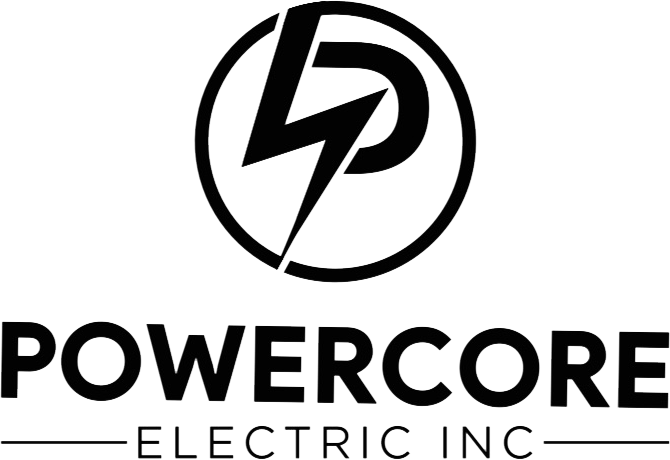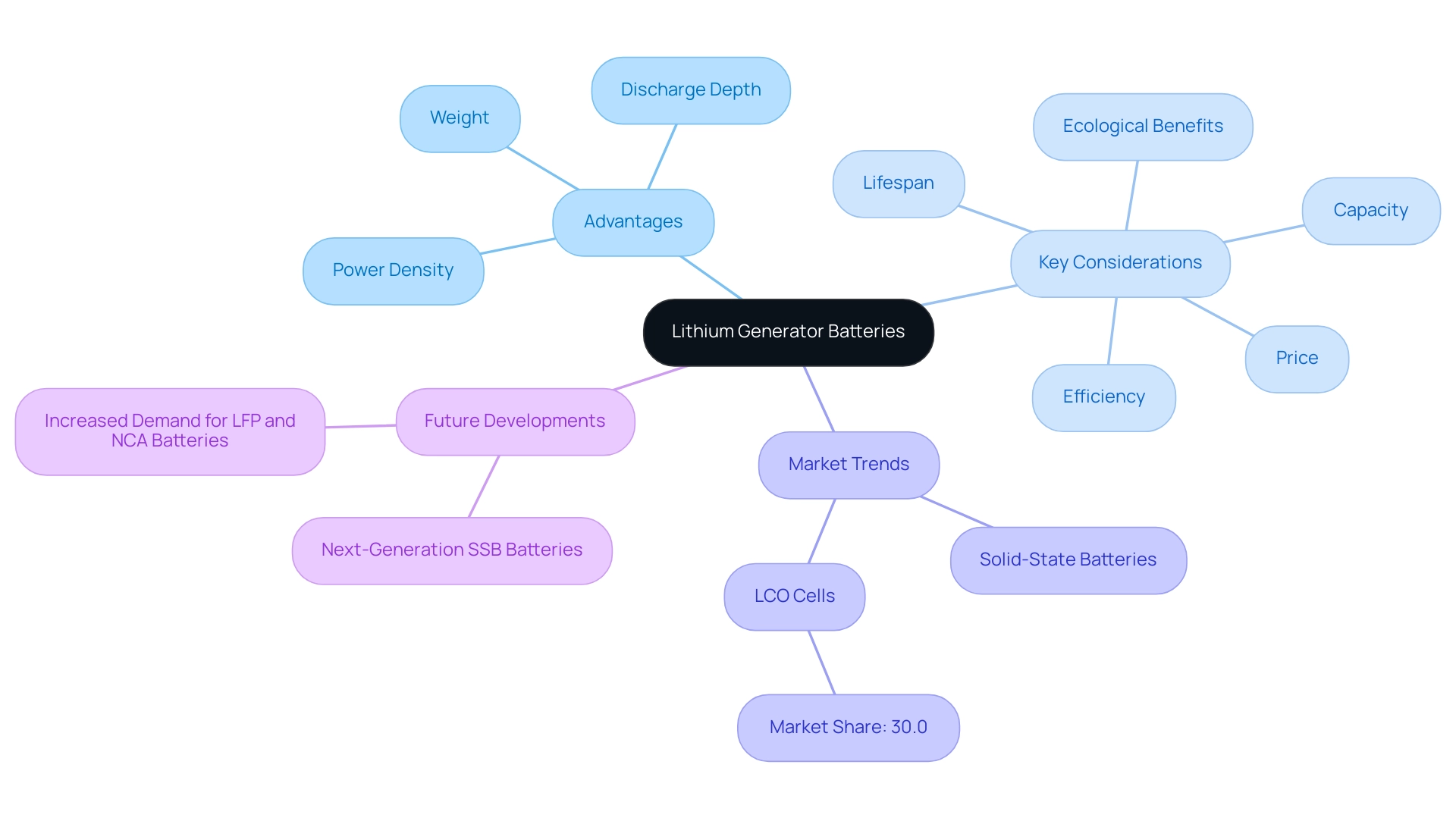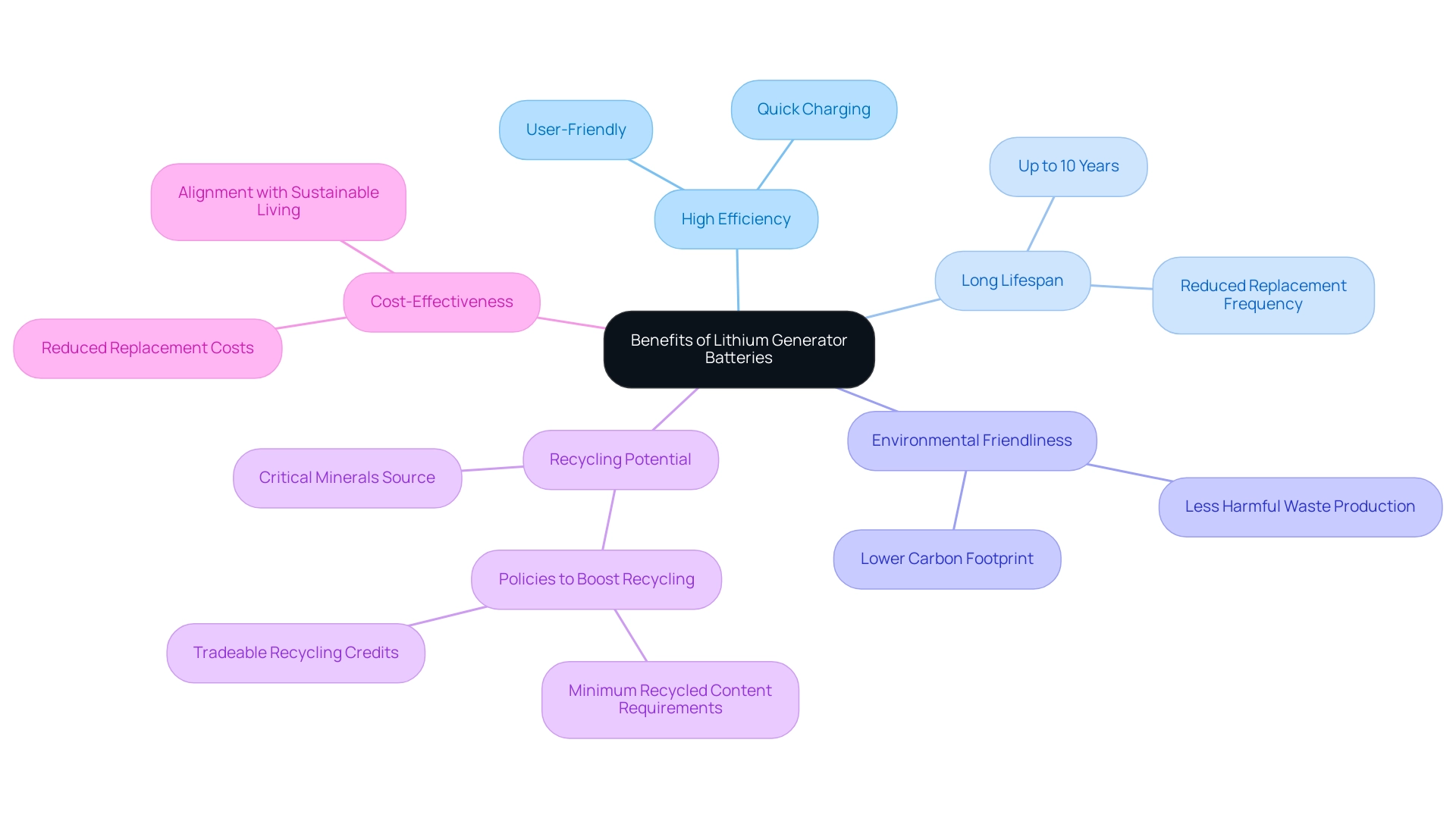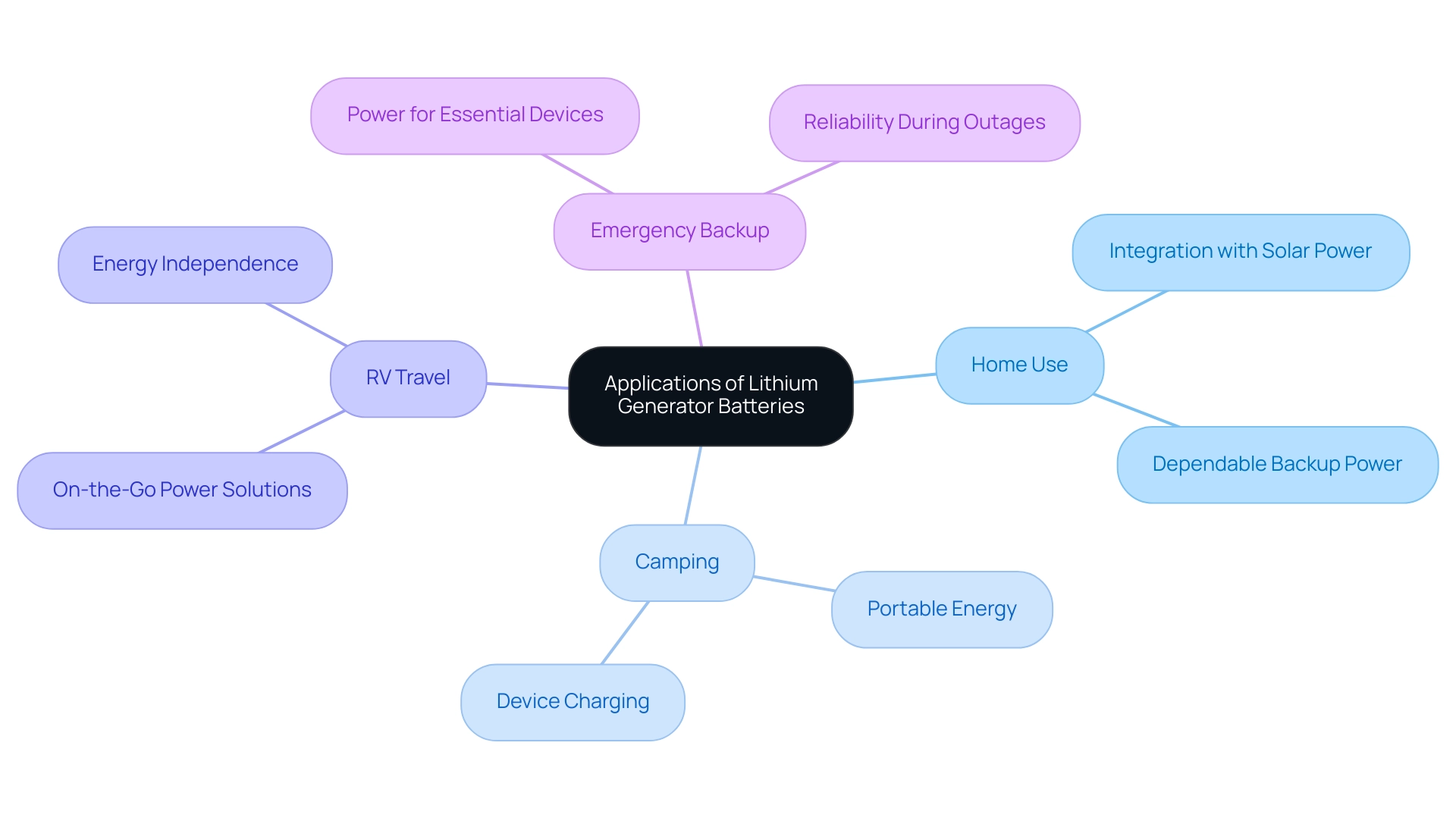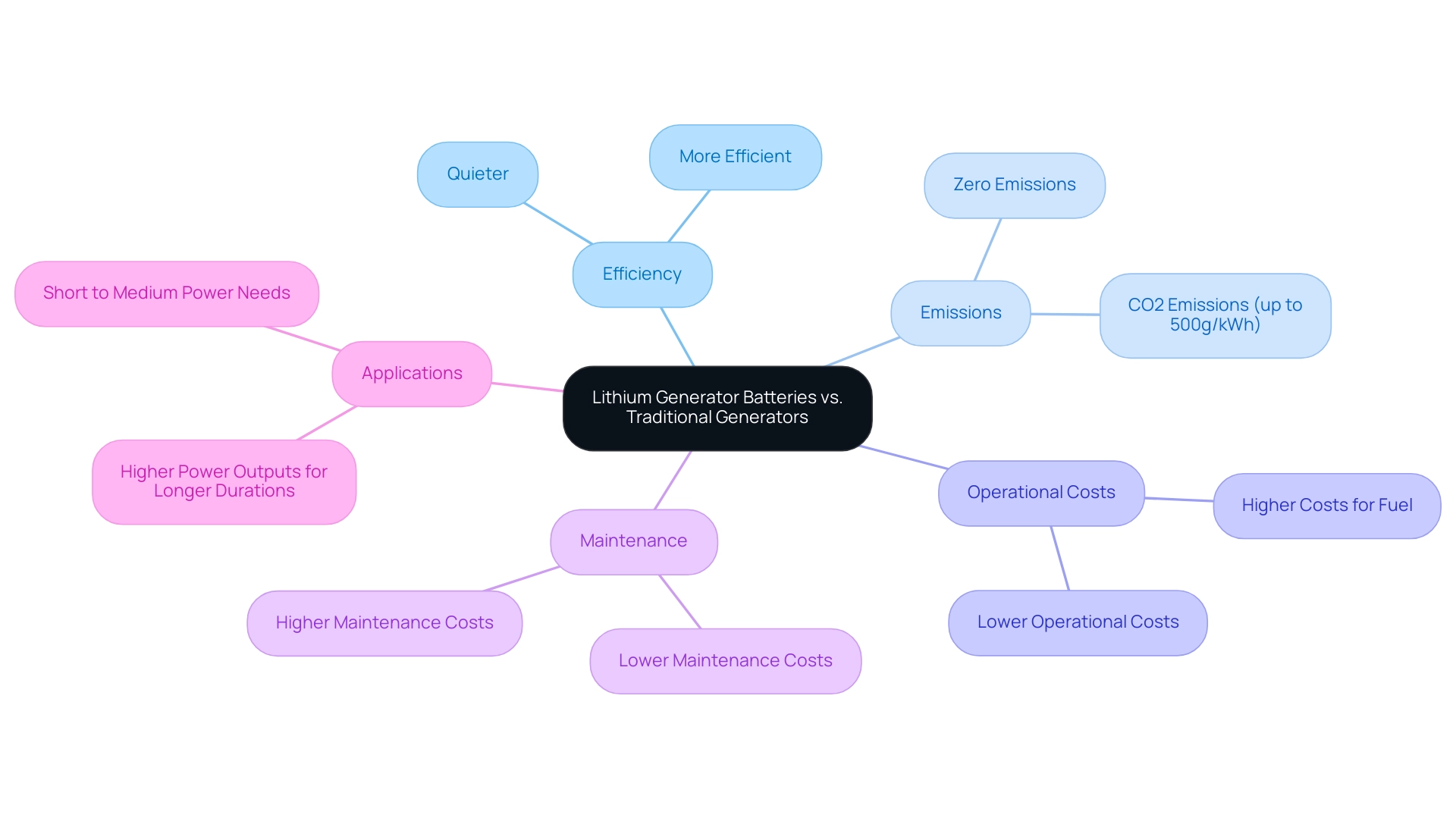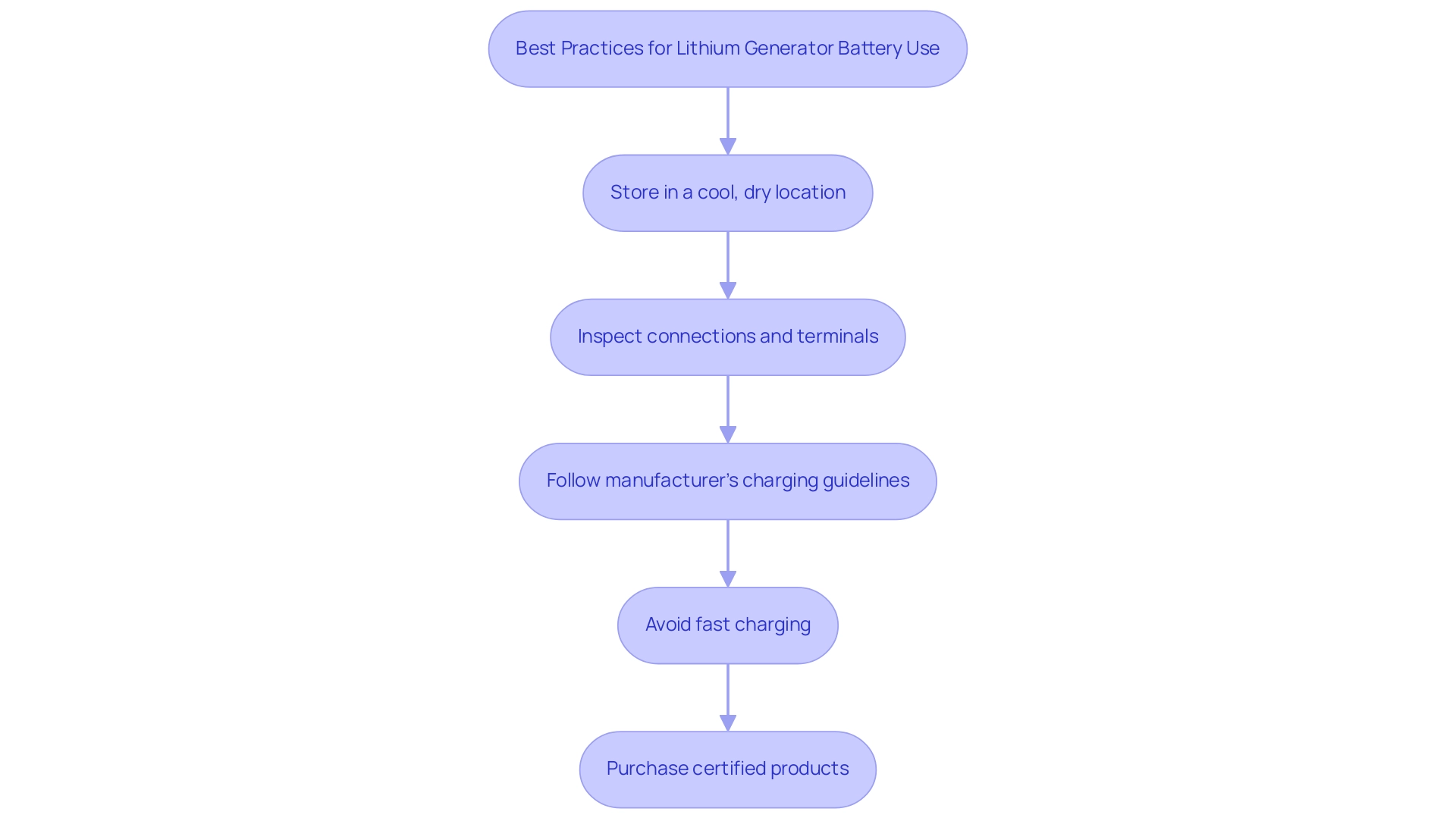Overview
Lithium generator batteries are advanced power storage solutions that offer significant benefits such as higher efficiency, lighter weight, and longer lifespan compared to traditional lead-acid batteries. The article supports this by detailing their advantages in various applications, including eco-friendly energy storage, backup power during outages, and their compatibility with renewable energy systems, highlighting their growing importance in sustainable living.
Introduction
In the quest for sustainable energy solutions, lithium generator batteries have emerged as a game-changer for homeowners seeking efficiency and reliability. These advanced batteries offer a remarkable upgrade over traditional options, combining lightweight design with high energy density to power everything from household appliances to outdoor adventures.
As the world shifts towards greener practices, understanding the benefits and applications of lithium batteries becomes essential for those looking to optimize their energy usage. With insights into their efficiency, longevity, and environmental impact, homeowners can make informed choices that not only enhance their energy independence but also contribute to a more sustainable future.
This article explores the key features, advantages, and best practices associated with lithium generator batteries, providing a comprehensive guide for anyone ready to embrace this innovative technology.
Understanding Lithium Generator Batteries: An Overview
Lithium generator batteries signify a major advancement in power storage technology, utilizing the capabilities of lithium-ion systems to effectively store and provide electrical power. Unlike conventional lead-acid cells, which can be cumbersome and less efficient, a lithium generator battery is not only lighter but also features a higher power density. This means they can hold more power in a smaller package, which is incredibly beneficial for a range of applications—from charging your portable devices to providing backup power for your entire home during outages using a lithium generator battery.
For eco-conscious homeowners, understanding these distinctions is crucial for making informed decisions that optimize their energy solutions, especially when incorporating renewable sources like photovoltaic energy and utilizing a lithium generator battery in their lifestyles. Key considerations for selecting a solar storage unit, such as a lithium generator battery, include:
- Capacity
- Efficiency
- Lifespan
- Price
- Ecological benefits
For instance, while lead-acid cells are generally cheaper upfront, they have a shorter lifespan and lower efficiency compared to a lithium generator battery.
Flow storage systems, on the other hand, provide longer cycle life and are better suited for larger installations but may come with higher initial costs. The lithium-ion cell recycling market is experiencing robust growth, with a CAGR of approximately 20.1%, highlighting the increasing relevance of these technologies in the energy storage sector. Beyond weight and size, these lithium generator batteries can be discharged more deeply without harming their lifespan, thereby improving durability and usability.
As Samsung recently mentioned, the company has unveiled next-generation solid-state energy storage devices (SSB), reflecting ongoing advancements in technology. Moreover, the demand for Lithium Cobalt Oxide (LCO) cells, which comprise over 30.0% market share in 2023 due to their high power density and safety, highlights the practical uses and advantages of lithium generator battery technologies in the market. Looking ahead, these advancements promise even greater efficiency and reliability for homeowners seeking sustainable energy solutions.
The Benefits of Lithium Generator Batteries: Efficiency and Sustainability
Lithium generator battery power sources stand out as a superior choice compared to traditional options, offering numerous benefits that resonate with sustainable living ideals. Their high efficiency translates to quicker charging and discharging cycles, making them incredibly user-friendly for eco-conscious homeowners. With an impressive lifespan of up to 10 years or even longer, these power sources significantly reduce the frequency and cost of replacements, saving homeowners money and minimizing the environmental impact by decreasing landfill waste.
Additionally, lithium cells are more environmentally friendly; they can be recycled, and their production generates less harmful waste compared to lead-acid cells. This recycling capability is crucial, as recent discussions suggest that recycling of batteries could become a vital source of critical minerals, promoting sustainability and reducing reliance on geographically concentrated resources. Moreover, targeted policies, such as minimum recycled content requirements and tradeable recycling credits, can significantly boost recycling growth, paving the way for more sustainable practices.
The U.S. Department of Energy’s recent allocation of $2.7 billion in funding to support domestic fuel production for commercial nuclear power plants further illustrates the governmental commitment to advancing sustainable power solutions. For eco-conscious homeowners, investing in a lithium generator battery as a power source means adopting a cost-effective solution while also reducing their carbon footprint, seamlessly aligning with their commitment to sustainable living practices. Insights from case studies on policy and regulatory frameworks for storage deployment reveal that effective policies are essential for overcoming barriers to adoption, reinforcing the importance of these advancements in facilitating market participation and ensuring a sustainable transition.
Moreover, homeowners ought to evaluate how lithium cells enhance other solar options, such as Tesla home chargers and government solar panel initiatives, to establish a comprehensive strategy for efficiency and sustainability.
Applications of Lithium Generator Batteries: Where and How They Are Used
Lithium generator battery cells are a fantastic option for eco-aware homeowners looking for dependable power solutions. Whether you’re embarking on a camping trip or journeying in an RV, these power sources provide the portable energy required to keep your devices charged and functional. Their significance grows even more during emergencies, providing dependable backup power during outages to ensure essential devices like refrigerators, lights, and medical equipment remain functional.
At home, rechargeable cells can effortlessly connect with photovoltaic systems, capturing and storing excess power produced during the day for utilization at night or during overcast times. To effectively combine lithium accumulators with your solar panels, follow these steps:
1. Evaluate your power requirements to determine the suitable capacity.
2. Select a compatible inverter that matches your solar system.
3. Connect the accumulator to the inverter and solar panels according to the manufacturer’s instructions.
This adaptability enhances your autonomy and contributes to a more sustainable lifestyle.
Looking forward to 2024, the adaptability of these power sources is expected to grow, with new uses arising to satisfy the rising need for effective and environmentally friendly solutions. In comparison to gas-powered generators, rechargeable cells, including lithium generator batteries, provide cleaner energy, reduced maintenance expenses, and quieter operation, making them a superior option for homeowners. Projections suggest a substantial increase in worldwide demand for these energy storage devices from 2022 to 2025, highlighting the escalating significance of them in the market.
As mentioned by the U.S. Energy Information Administration, geopolitical factors such as sanctions on Russia’s oil sector could further affect the supply and demand for this resource. Furthermore, recycling of energy storage units presents a vital opportunity to recover critical minerals, supporting a more sustainable supply chain as we move towards eco-friendly energy solutions.
Lithium Generator Batteries vs. Traditional Generators: A Comparative Analysis
When it involves selecting between lithium generator batteries and conventional generators, comprehending the distinctions can significantly assist homeowners in making a knowledgeable choice. Lithium generator batteries excel in several key areas: they are generally quieter, more efficient, and come with significantly lower operational costs since they don’t rely on fuel. According to emissions statistics, traditional generators can emit up to 500 grams of CO2 per kilowatt-hour, contributing to air pollution—a concern that many eco-conscious homeowners are keen to avoid.
In contrast, lithium generator batteries produce zero emissions during operation, making them a cleaner choice for residential use. While traditional generators can deliver higher power outputs for longer durations, they often entail higher maintenance costs and raise environmental concerns due to their emissions. For instance, Briggs & Stratton’s proprietary NGMax™ technology enhances the output power of generators using natural gas, which can be a more eco-friendly alternative.
However, lithium generator batteries excel in applications with short to medium power needs, making them perfect for residential use, camping trips, or outdoor activities. Furthermore, evaluating the optimal power storage solutions for effective resource retention, you can attain even greater advantages. For instance, the price of renewable energy storage systems can vary from $5,000 to $15,000 based on capacity and brand, yet they can help homeowners save money over time by decreasing dependence on conventional electricity sources.
As sunlight power becomes more common, comprehending the expenses linked with photovoltaic panels and EV charging solutions provides valuable insight. A recent case study forecasts that by 2030, lithium generator battery systems will be financially viable, with substantial decreases in investment expenses anticipated because of technological progress. By understanding these differences and evaluating the anticipated cost-efficiency of rechargeable energy storage systems and solar energy alternatives, you can more effectively determine your particular energy needs and choose the most appropriate backup power option for your residence.
Safety and Maintenance: Best Practices for Lithium Generator Battery Use
To ensure the safe and effective use of lithium generator battery power sources, it’s crucial to follow some essential best practices. Always store your power sources in a cool, dry location to prevent overheating and avoid exposing them to extreme temperatures, which can lead to performance issues or hazards. Regularly inspect connections and terminals for any signs of corrosion or damage, which can compromise safety.
Additionally, adhere to the manufacturer’s guidelines regarding charging and discharging cycles. It’s important to note that lithium-ion cells can safely charge at rates of approximately 1C to 2C, allowing for a full charge in 30 minutes to an hour; however, avoid fast charging unless absolutely necessary to maintain cell health, as fast charging can increase the risk of degradation. In fact, the fire rate for electric vehicles powered by lithium-ion cells is about 0.03% per vehicle per year, underscoring the importance of proper maintenance and safety practices.
As Peter Simon from Gallagher Bassett emphasizes, “But even with the new laws, people are still buying and selling these non-certified energy sources online,” which highlights the critical need for purchasing certified products to ensure safety. By following these best practices, homeowners can not only extend the lifespan of their batteries but also significantly enhance safety during the operation of their lithium generator battery. A little attention to maintenance goes a long way in ensuring that you can enjoy the benefits of your backup power solutions while minimizing risks.
Conclusion
Lithium generator batteries are revolutionizing the way homeowners approach energy storage and usage, offering a blend of efficiency, sustainability, and practicality. With their lightweight design and high energy density, these batteries provide an excellent alternative to traditional options, making them ideal for a variety of applications—from powering home appliances to supporting outdoor adventures. Their longevity and recyclable nature further enhance their appeal, allowing homeowners to reduce costs and environmental impact over time.
Choosing lithium generator batteries aligns perfectly with the growing trend toward sustainable living. These batteries not only offer significant savings in replacement costs due to their impressive lifespan but also contribute to a cleaner environment by producing zero emissions during operation. As the demand for sustainable energy solutions increases, integrating lithium batteries with solar power systems can amplify energy independence and efficiency, making them a wise investment for eco-conscious individuals.
As technology continues to evolve, homeowners can expect even greater innovations in lithium battery applications and efficiency. By understanding the benefits and best practices of these advanced batteries, individuals can confidently embrace this technology, ensuring they not only meet their energy needs but also contribute positively to the planet’s future. The transition to lithium generator batteries is not just a step toward energy independence; it’s a commitment to a more sustainable lifestyle that benefits everyone.
